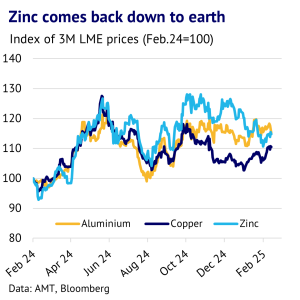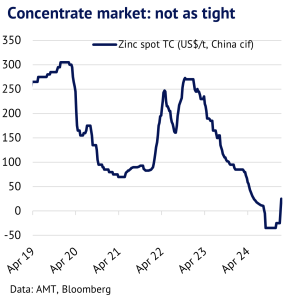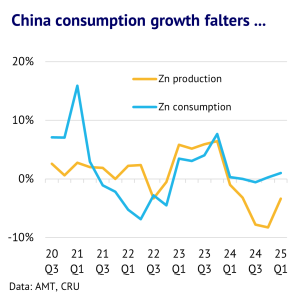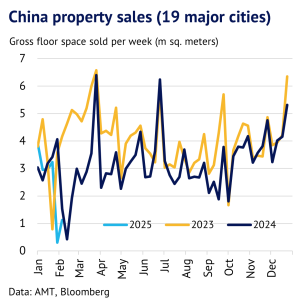14 February 2025: Zinc prices outperformed in the second half of last year, but are now paying the price for this overexuberance, with a fall in early 2025. Speculators have pared back their positions, but more important is that fundamentals have started to weaken. Growth in zinc mining is accelerating, which should ease some of the pressure on smelters. Chinese smelter capacity is also being boosted. Meanwhile, demand in China looks wobbly, as the central government steps in to bail out heavily indebted property developers and sales trundle along at a low level. We expect zinc prices to remain range-bound for now, favouring mean reverting models.
Zinc prices tumble, as fundamentals soften. So far this year, LME 3-month zinc prices have significantly underperformed markets like aluminium and copper, as speculators pulled back and fundamentals started to weaken. The zinc price is down 4% YTD, whereas copper is up 8% and aluminium is up 3% (data to 13 February), with fresh shorts on the LME overpowering fresh longs. While the base metals complex is being buffeted by US trade policy, and fears about a global trade war, fundamentals are driving this divergence. It is also worth noting that zinc outperformed the rest of the complex in H2 2024, and overshot fair-value, and so the recent underperformance was not particularly surprising.

Mine production set to accelerate. While zinc demand growth has been feeble in the past year, the market was kept very tight by a lack of concentrate, which fed through into significant cuts by smelters. Unfortunately for the bulls, this part of the story is set to change. First, the Tara mine in Ireland returned to full operation in October, with the owner Boliden reporting 8% growth in output in Q4 2024. Second, according to CRU, ex-China mine output should grow by 3.3% this year, due to the ramp-up of recently started operations in DRC, Mexico and Russia and a bounce-back at Antamina in Peru. As we show in the chart below, spot treatment charges (TCs) for zinc were in negative territory in late 2024, but recovered a little in the first few weeks of this year, showing that miners are losing their negotiating strength.

Smelters in China are struggling, but capacity is ramping up. The latest intelligence from China indicates that smelters in the country are still suffering from a lack of raw materials, but the pain should ease as the year develops. According to CRU, Chinese smelter output was down 6% y/y in January and they forecast a 3% y/y drop in February. The country is in the process of bringing online the giant Huoshaoyun mine, but this does not appear to be coming through quickly enough, due to operational and logistical challenges. As a result, China was forced to import 242kt (contained metal) of zinc concentrate in December 2024. Counterintuitively, Chinese smelter capacity is set to jump by 8% this year, despite the challenge of securing raw materials. Kunlun Zinc is expected to start its new smelter in Xinjiang province and there are some other small capacity additions in the pipeline.
Global, benchmark contract TCs are likely to tumble from last year’s US$165/t, and the extent of the fall will provide valuable insight into about how quickly the concentrate market is moving from deficit to surplus and who is winning the commercial battle between miners and smelters. Contract terms are normally agreed in March or April.
Downstream demand still looks lacklustre. While smelters might be ramping up in China, demand for zinc looks feeble, suggesting that the refined market is likely to move into oversupply soon as well. CRU is currently estimating Chinese demand growth of 1% in Q1 2025, following zero growth in 2024.

There are two main problems for zinc demand. Firstly, it is not getting a boost from the green energy transition, unlike metals like copper and aluminium. Secondly, the construction market in China remains very depressed. This month saw the central government stepping in to bail out China Vanke, one of the country’s real-estate giants. Authorities are trying to plug a US$6.8bn funding gap.
The underlying problem is that Chinese house prices are still falling, with the most recent data showing a 5.7% y/y drop for newly built homes and an 8.1% y/y fall for existing homes in December 2024. Property sales are also in the doldrums, as we show below. Finally, the broader picture for construction looks bearish, with the construction PMI falling back to 49.3 in January 2025, down from 53 in December 2024. We still believe that recent government stimulus measures will underpin the market this year, but the chances of any meaningful upturn in zinc demand from construction seems very low for the time being.

Market trapped in a low demand environment. Overall, we expect a very slow recovery in zinc demand this year, while production growth is likely to accelerate through the year. The global zinc market is expected to be moderately oversupplied. However, LME prices have already fallen to take account of recent bearish news and we expect range-bound trading in the months ahead, favouring mean reverting models over trend following models. Our previously published forecast from mid-January predicted that the LME three-month zinc would average US$2,858/t in Q4 2025, which we have not revised.